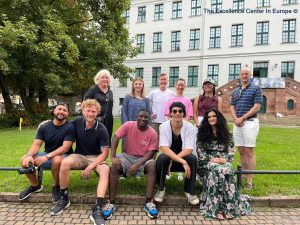Diversity comes in many forms, diversity of culture and traditions, gender, ethnic background, languages spoken, religions. Diversity enriches an environment in many ways.
For instance, biodiversity encourages the flourishment of the eco-system and the stimulation of new life forms. When a variety of people come together who each hold some unique or idiosyncratic quality, the hub becomes a place of innovation inspired by different ways of thinking and acting.
The Excellence Center
Halle is a diverse city as described in the article (Link) on how Halle has transformed demographically over the past 5 years, as well as the consequences of this. However, the excellence centre is a paragon of this diversity.
The center is a place of collaboration of permanent staff, volunteers, refugees, as well as visitors. Arabic, German and English and even Chinese or Spanish flow throughout the center in conversation.
People at the centre originate from a range of countries including but not limited to Syria, Palestine, England, Bosnia, Serbia, Italy, and America.
Diverse diversity in the Excellence Center
Throughout the day, language learning is taking place outside the class room. “What does … mean in English/Arabic/German/Bosnian?” This diversity of language makes people feel at home with the ability to converse in their native tongue while exploring foreign languages.
A mix of women and men come into contact with the centre as volunteers, permanent staff and refugees. This enriches the environment as a place of gender equality. The Excellence Center in Palestine, Hebron is run by 2 female heads, including Marwa who visited Halle’s Excellence Center just recently. She stands as a strong woman in charge of running a hub of people, working in tandem with Rafat who runs the centre in Halle.
Difference exists between the Arabic wold and Europe but also within each country in these areas. This diversity exists linguistically and religiously as well as in tradition and other forms and has been discussed throughout the centre. For example, in Kurdish culture it is rarer for a Muslim woman to wear a hijab in comparison within Syrian tradition.
In Jordan more recent generations are less likely to have such large families where as in Syria generally the size of families remains consistently large.
While cuisine can be shared across countries, some dishes are more popular in some countries and others less so. Even if 2 countries are considered to have the same process of democracy, the difference between how this works in practice in both places can be notable, like Germany’s proportional representation compared to the UK’s first past the post system. Coming to understand diversity is an education.
The point is that while labels and differences exist, they are advantageous and not isolating. Humanity is shared with diversity.
The difference between integration and assimilation
Assimilation is defined by a foreigner having to adapt to a new environment in a way that makes them “fit in” and similar to those who already live there. In the process of assimilation, an outsider could potentially lose part of their culture or identity.
Note that a person does not have to be a foreigner in terms of where they are from, but a foreigner in the sense that they are foreign to the new environment in some way. Integration, on the other hand, allows for an outsider to keep their integral ways of live and beliefs in the different environment. Which to you sounds more like a multicultural society? Do you think integration and assimilation happen separately or together?
As the Excellence Center in Halle was created by people who migrated to Germany, it is founded on principles of the importance of integrating all diversity which may arrive here.



